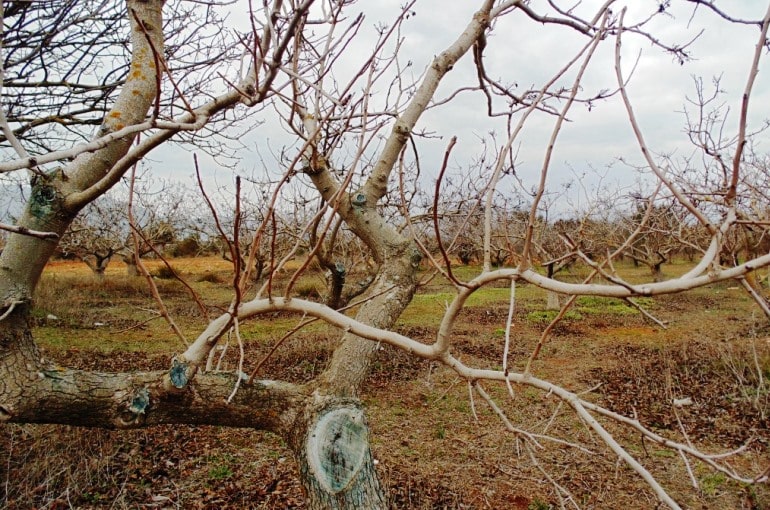Pistachio Tree Training and Pruning

This post is also available in:
This post is also available in:
![]() Español (Spanish)
Español (Spanish) ![]() Français (French)
Français (French) ![]() Deutsch (German)
Deutsch (German) ![]() Nederlands (Dutch)
Nederlands (Dutch) ![]() العربية (Arabic)
العربية (Arabic) ![]() Türkçe (Turkish)
Türkçe (Turkish) ![]() 简体中文 (Chinese (Simplified))
简体中文 (Chinese (Simplified)) ![]() Italiano (Italian)
Italiano (Italian) ![]() Português (Portuguese (Brazil))
Português (Portuguese (Brazil))
How to train and prune pistachio trees
In general, pistachio trees need less pruning than other fruit trees (apple, citrus etc.) However, the same rules of fruit trees pruning apply. In a few words, we prune (or “train”) young trees during their second spring in order to determine their shape (crown skeleton). The shape is very important and can affect production quantity, quality and ease of harvesting or other farming activities. On the other hand, we prune mature trees in order to maintain their shape and open up the inner part of the tree, so that aeration and sunlight penetration will be improved. We also prune mature trees in order to remove broken, weak or diseased branches, and of course get rid of suckers. All the previous operations promote fruit production in the long term.
Young pistachio trees are usually trained during their second spring in a way so that they can finally bear heavy crops that can be easily harvested. We can manage the proper shape by tipping the top of the tree once the scion (the upper part of the tree that was budded to rootstock) reaches a height of 40 inches (1 meter). This tipping will promote the appearance of 3-4 primary branches from this point. These will be selected as the primary branches of the tree. They will form the basic skeleton of the tree and thus they must not cross each other. We then tip each of the primary branches when they reach a length of 15 inches (38 cm). This promotes the growth of secondary branches from each primary branch, which we will also tip when they reach a length of 25 inches (63 cm.)
In general, pruning of a healthy and mature pistachio tree should be light (remove maximum 10-15% of the tree crown), because severe pruning (more than 30% of the crown) has been found to increase the percentage of closed fruits. However, very weak trees should be pruned severely. Pruning should be normally held during late winter – early spring and definitely when the tree is still dormant. During the summer, we can remove young shoots, having a length of 30 inches (75 cm) or more, so as to avoid their possible bending downwards. The desired angle of shoots is about 45 degrees. This operation promotes side vegetation and speeds up the development of the crown skeleton. The inner part of crown of trees should be kept open, so that it will have access to plenty of sunlight. Sunlight is necessary for the formation of flower buds and thus is proportionate to production. After creating the basic skeleton of the tree crown, only light pruning is allowed. We generally cut 1 year limbs to 20 inches (50 cm.) Remember that in mature trees of 15 years and older, the fruit bearing parts are always at the upper half of the canopy. Consequently, pruning upper limbs must be limited.
Male pistachio trees are usually not pruned. They normally reach a greater height than the female trees, because the pollination of pistachio trees is facilitated this way. Male trees are pruned only when they hinder the growth of females, when they cause difficulties in harvest and when we try to delay their flowering.
You can enrich this article by leaving a comment or photo of your pistachio trees pruning methods.
1.) Pistachio Tree Information
2.) How to grow Pistachio Tree from nut
3.) Starting a Pistachio Orchard
4.) Pistachio Tree Growing Conditions
5.) Pistachio Tree Propagation and Pollination
6.) Pistachio Tree Soil Conditions and Preparation
8.) Pistachio Tree Training and Pruning
9.) Pistachio Tree Fertilizer Requirements
10.) Pistachio Tree Water Requirements
11.) Pistachio Tree Harvest & Yields
12.) Pistachio Tree Diseases & Pests
Do you have experience in Pistachio Tree cultivation? Please share your experience, methods and practices in the comments below. All the content you add will be soon reviewed by our agronomists. Once approved, it will be added to Wikifarmer.com and it will influence positively thousands of new and experienced farmers across the world.








































































